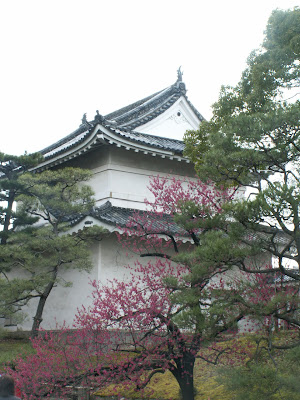Miyajima
I'm feeling diligent so...
Following the two days in Kyoto and preceding the Hiroshima excursion here is the write-up for Miyajima Island. We arrived early into Hiroshima and checked-in at the hotel. We were given some maps and a free tram pass, which was a nice touch. The next two days in Hiroshima took some scheduling. As much as I wanted to see the A Bomb Dome, we only had one night here and so we spent the first day on Miyajima, which was said to be worth seeing after dark.
The tram took us through the commercial area of Hiroshima, much like any shopping centre, and onto the outskirts and finally the docks. We jumped on a ferry which shuttled us towards Miyajima. This island is one of the three scenic views of Japan, another being the islands in Matsushima (near Keiko's house) and the third is Amanohashidate in west Japan and appears to be quite beautiful. And so it should when it translates as "Bridge of Heaven". To find out how to view the sand bridge, it's worth following the link!
Miyajima - "Shrine Island" - is famous for the deer that roam the island freely, as well as the monkeys on top of Mt Misen, the highest point. The other tourist-pulling device is Itsukushima Shrine and the red 'torii' gate.
The deer were mischievous.
Walking from the harbour to the gate, the tide was out and we could see many people bent over on the wet sand doing something. Up closer, they were cockling!
We could walk all the way out to the gate (I'd checked the low and high tide times and hoped that we would be able to see both before the last boat); it was impressive, not least for withstanding the tide. The structure was so wide.
The shrine was also picturesque, raised on stilts, and we even saw a traditional wedding.
That was about as much as I knew of Miyajima and I was dreading hanging around until dark to see the high tide. Fortunately, the island offered a great deal more. I didn't realise it was so enormous.
We took the path up past the small village towards a hiking trail and the cable car. The signs explained how far it was; we took the leisurely option!
The first cable car took us upwards onto a peak, with signs advising us to be aware of the monkeys. A short walk around the path was a second ropeway which took us onto Mt Misen, at 530 metres.
The rest of the decent walk was past a few temples and some passes formed by boulders towards the summit.
The view was absolutely incredible, a 360 panorama of Hiroshima, other islands, and the Seto Inland Sea - between Honshu and Shikoku. My fault entirely that I didn't know any of this existed (research, people, research!), we didn't have much time to take in the sights as we were worried about missing the last times down to the base of the island.
Unfortunately, no monkeys except these two:
From this height, it was easy to imagine on a clear day why Miyajima was named one of the three scenic spots in Japan.
The sun was slowly setting although we had a bit of time to kill and stumbled upon this treasure. Hard to believe but it's not listed in guidebooks as a reason to visit Miyajima, it is in fact "The Largest Rice Scoop In The World"! I know, stop and compose yourselves. Truly something, hey. Made from 300 year old Zelkova tree and 7.7 metres long and weighing 2.5 tonnes. According to the sign, it has been placed here to symbolise Miyajima as the birthplace of the rice scoop, as well as celebrating the Shrine becoming a World Heritage Sight.
If anything, it's good for a question on Eggheads one day.
Hungry, we found a small restaurant and we were the only customers the woman had. We sat at a counter in front of a surface metal plate, on which she cooked everything before our eyes. Keith opted for ramen, and Mum and I had a Hiroshima delicacy 'okonomiyaki' - basically a pancake with everything.
I had a limited conversation with her whilst she cooked, but more than anything we enjoyed watching the size of these pancakes grow by the minute. Layers of egg, noodles, pancake mixture, vegetables, until they were as big as the plates. It was an impressive skill and she seemed laid back whereas I would've been stressed keeping on top of it and trying to flip the pancakes. They were only about four pounds each as well!
When we left the restaurant it was dark. We turned a corner to see this:
The tide was in and the gate was illuminated. It was spectacular.
We took some pictures and then a ferry back to the mainland and onto the hotel. I should mention the hotel was fine, except for a bizarre feature: the radio station which only played the Rocky theme tune back to back. We listened the next morning whilst we prepared for Hiroshima and felt all energetic, until the music died down and started straight back up again. Even more strangely, we listened a few times! Some other bloggers have mentioned this mysterious station but I've never found out where or why it's broadcast.
---
The next day was Hiroshima, which I've written about. Afterwards, we took a shinkansen back to Tokyo, stopping for Mum and Keith's final night at Shin Yokohama's Ramen Museum; a brilliant end to a brilliant trip.







































































